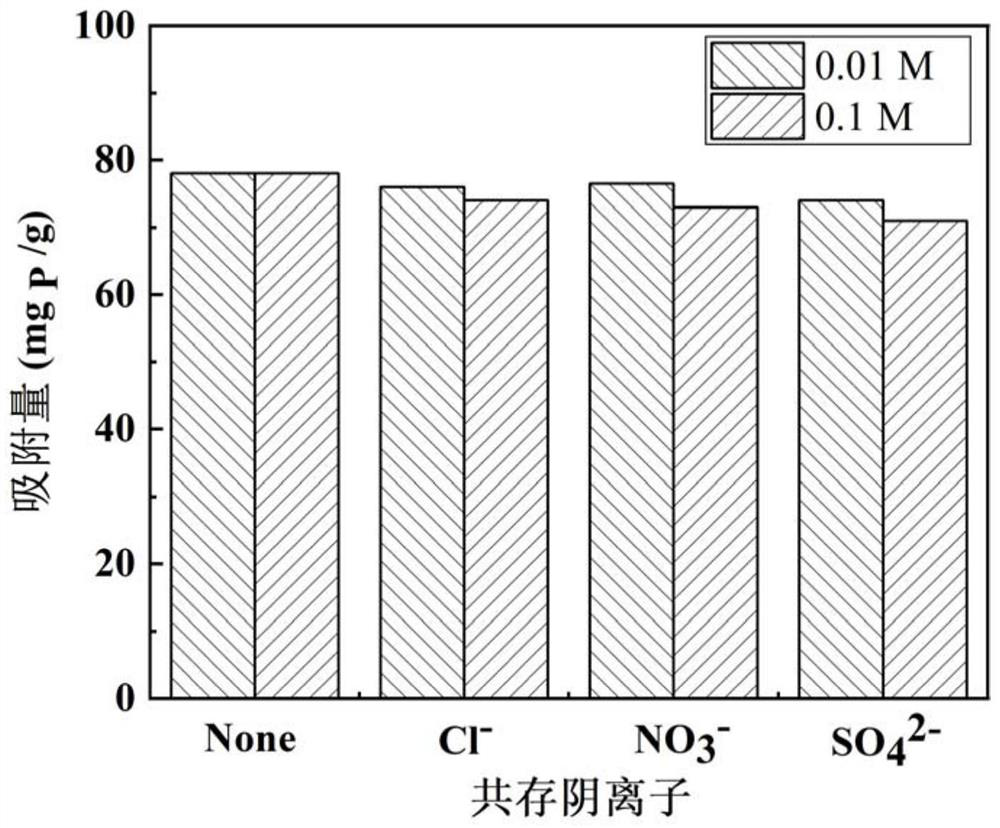Method for preparing modified biochar from plant waste and application
A technology of plant waste and biochar, applied in chemical instruments and methods, water pollutants, water/sludge/sewage treatment, etc., can solve the problem of low P adsorption effect, achieve hydrophilicity and polarity enhancement, The effect of short processing cycle and simple operation
- Summary
- Abstract
- Description
- Claims
- Application Information
AI Technical Summary
Problems solved by technology
Method used
Image
Examples
Embodiment 1
[0036] Example 1 Modified biochar with phosphate adsorbent prepared from agricultural waste residue ramie leaves
[0037] The collected residual ramie leaves are washed, dried, crushed, passed through a 80-mesh sieve, and dried at 65°C to a constant weight to prepare a powder. The magnesium chloride solution is mixed with the ramie leaf powder. The mass ratio of magnesium ions to ramie leaf powder is 0.12:1, the mixed solution was placed in an air bath constant temperature shaking box, and was continuously shaken at 160rpm at 25°C for 24h, and then the solution was evaporated to a nearly viscous state under the conditions of 120rpm and 80°C with a magnetic stirrer, and then transferred to a blower Dry in a drying oven overnight at 105°C, take it out, crush it with a high-speed multifunctional pulverizer for 2 minutes, pass through a 0.5mm sieve, and finally place it in an electric heating tube furnace for pyrolysis, and carry out pyrolysis reaction in a nitrogen environment. T...
Embodiment 2
[0038] Example 2 Modified biochar with phosphate adsorbent prepared from agricultural waste residue ramie leaves
[0039] The collected residual ramie leaves are washed, dried, crushed, passed through a 80-mesh sieve, and dried at 65°C to a constant weight to prepare a powder. The magnesium chloride solution is mixed with the ramie leaf powder. The mass ratio of magnesium ions to ramie leaf powder is 0.24:1, the mixed solution was placed in an air bath constant temperature shaking box, and was continuously shaken at 160rpm at 25°C for 24h, and then the solution was evaporated to a nearly viscous state under the conditions of a magnetic stirrer at 120rpm and 80°C, and then transferred to a blower Dry in a drying oven overnight at 105°C, take it out, crush it with a high-speed multifunctional pulverizer for 2 minutes, pass through a 0.5mm sieve, and finally place it in an electric heating tube furnace for pyrolysis, and carry out pyrolysis reaction in a nitrogen environment. The...
Embodiment 3
[0040] Example 3 Modified biochar with phosphate adsorbent prepared from agricultural waste residue ramie leaves
[0041]The collected residual ramie leaves are washed, dried, crushed, passed through a 80-mesh sieve, and dried at 65°C to a constant weight to prepare a powder. The magnesium chloride solution is mixed with the ramie leaf powder. The mass ratio of magnesium ions to ramie leaf powder is 0.48:1, put the mixed solution in an air bath constant temperature shaking box, and continuously shake it at 160rpm at 25°C for 24h, then evaporate the solution to a nearly viscous state under the conditions of 120rpm and 80°C on a magnetic stirrer, and transfer it to a blower Dry in a drying oven overnight at 105°C, take it out, crush it with a high-speed multifunctional pulverizer for 2 minutes, pass through a 0.5mm sieve, and finally place it in an electric heating tube furnace for pyrolysis, and carry out pyrolysis reaction in a nitrogen environment. The conditions are as follo...
PUM
 Login to View More
Login to View More Abstract
Description
Claims
Application Information
 Login to View More
Login to View More - R&D
- Intellectual Property
- Life Sciences
- Materials
- Tech Scout
- Unparalleled Data Quality
- Higher Quality Content
- 60% Fewer Hallucinations
Browse by: Latest US Patents, China's latest patents, Technical Efficacy Thesaurus, Application Domain, Technology Topic, Popular Technical Reports.
© 2025 PatSnap. All rights reserved.Legal|Privacy policy|Modern Slavery Act Transparency Statement|Sitemap|About US| Contact US: help@patsnap.com


